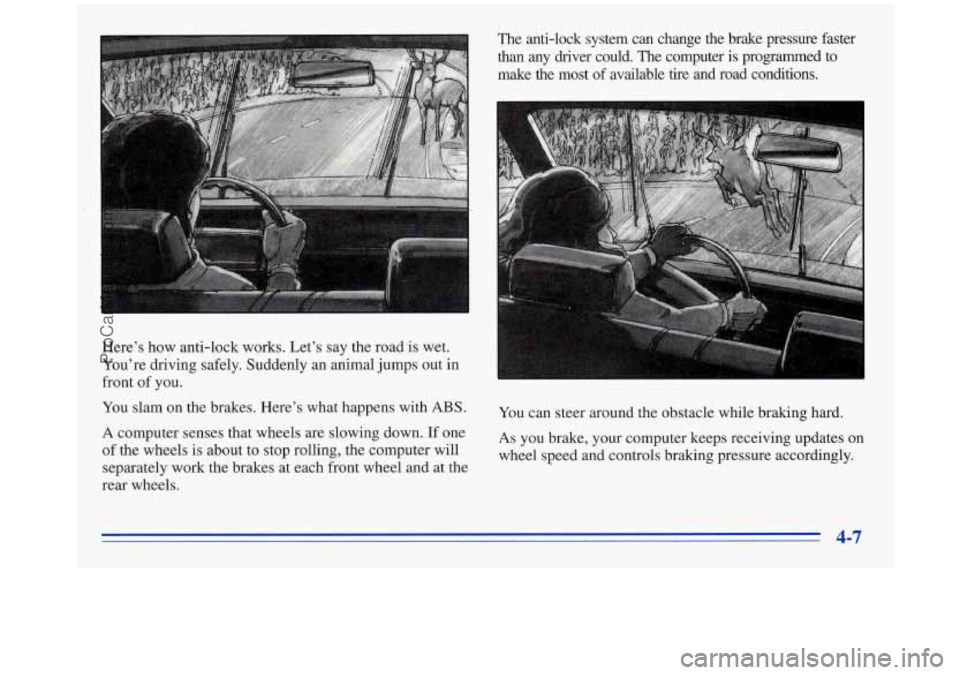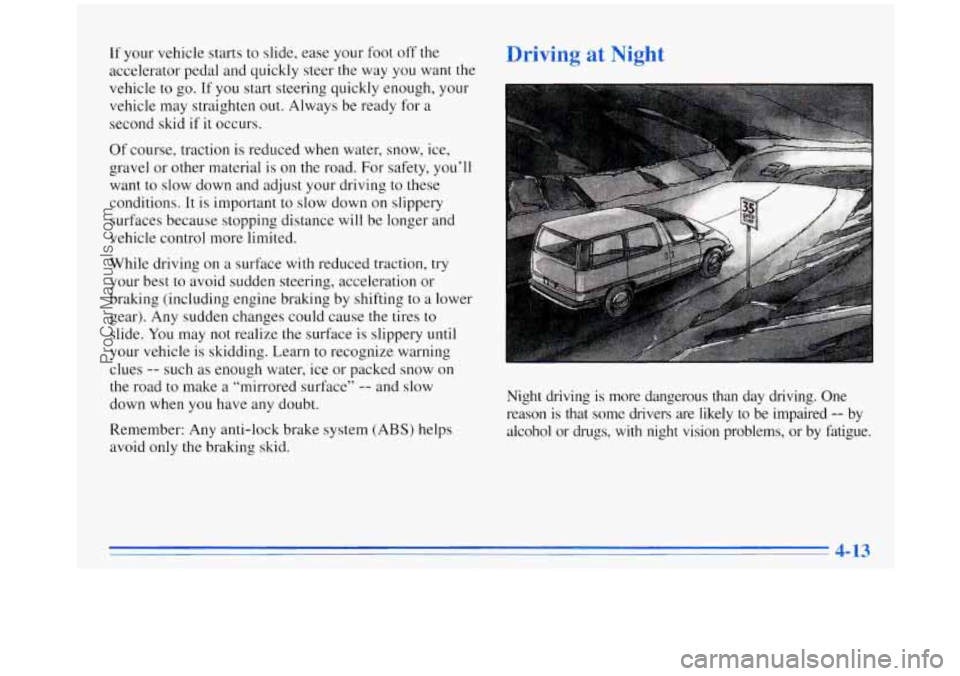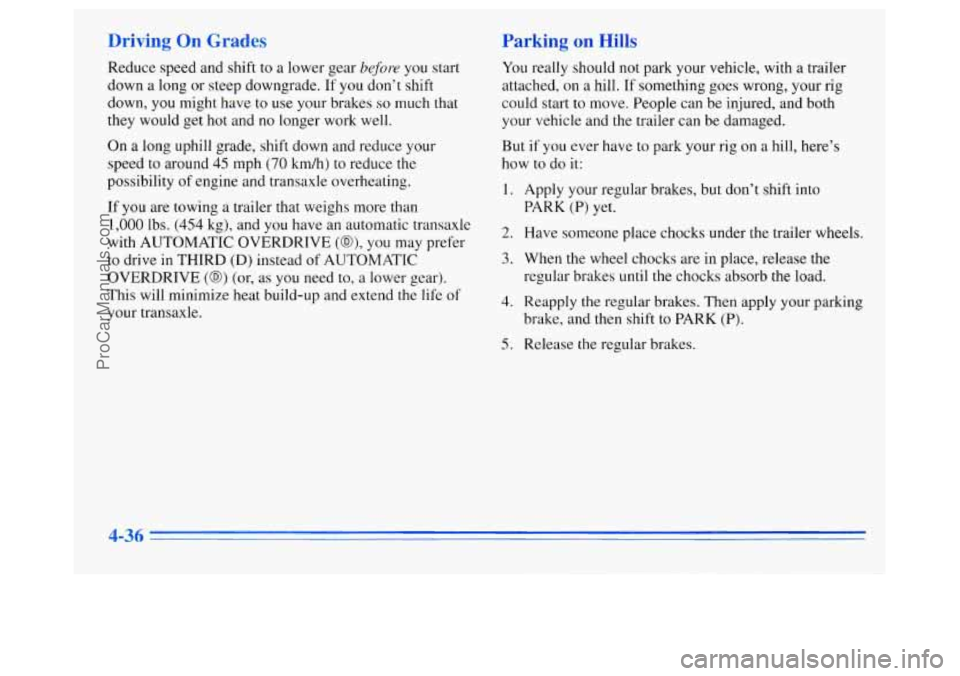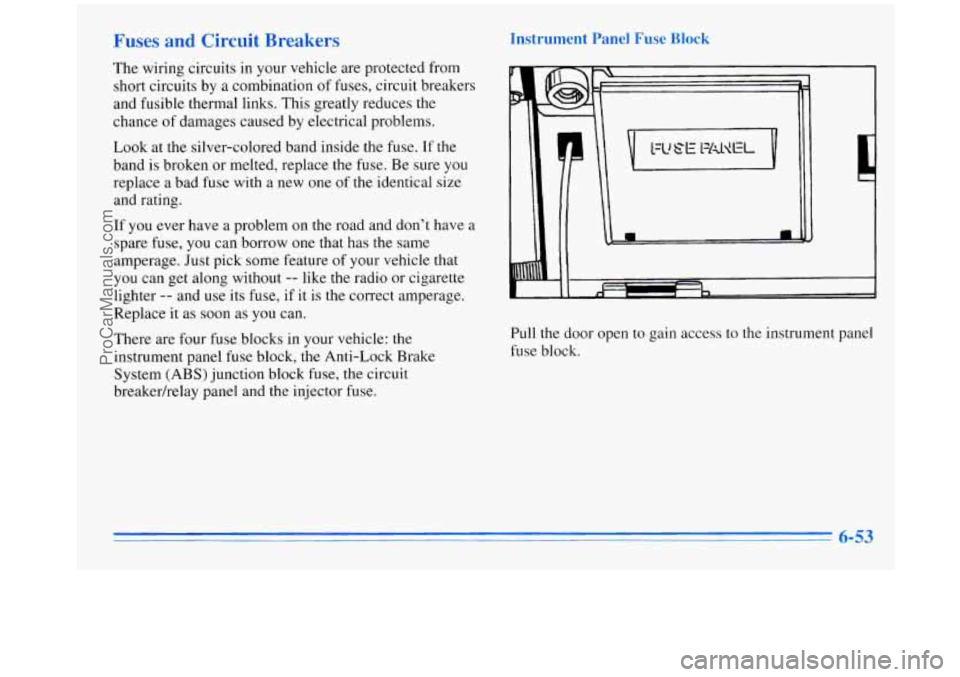ABS OLDSMOBILE SILHOUETTE 1996 Owners Manual
[x] Cancel search | Manufacturer: OLDSMOBILE, Model Year: 1996, Model line: SILHOUETTE, Model: OLDSMOBILE SILHOUETTE 1996Pages: 372, PDF Size: 19.39 MB
Page 180 of 372

Avoid needless heavy braking. Some people drive in
spurts
-- heavy acceleration followed by heavy
braking
-- rather than keeping pace with traffic. This is a
mistake. Your brakes may not have time to cool between
hard stops. Your brakes will wear out much faster
if you
do a lot of heavy braking. If you keep pace with the
traffic and allow realistic following distances, you will
eliminate a lot of unnecessary braking. That means
better braking and longer brake life.
If your engine ever stops while you’re driving, brake
normally but don’t pump your brakes. If you do, the
pedal may get harder to push down.
If your engine
stops, you will still have some power brake assist. But
you will use it when you brake. Once the power assist is
used up, it may take longer to stop and the brake pedal
will be harder
to push.
Anti-Lock Brakes
Your vehicle has anti-lock brakes (ABS). ABS is an
advanced electronic braking system that will
help
prevent a braking skid.
When you start your engine, or when you begin to drive
away, your anti-lock brake system will check itself. You
may hear a momentary motor or clicking noise while
this test
is going on, and you may even notice that your
brake pedal moves a little. (You may also hear a clicking
noise
if you leave the ignition in the RUN position for
about four seconds before starting the vehicle.) This
is normal.
If there’s a problem with the
anti-lock brake system, this
warning light will stay on or
flash. See “Anti-Lock
Brake System Warning
Light”
in the Index.
4-6
ProCarManuals.com
Page 181 of 372

The anti-lock system can change the brake pressure faster
than any driver could. The computer is programmed to
make the most
of available tire and road conditions.
L
Here’s how anti-lock works. Let’s say the road is wet.
You’re driving safely. Suddenly an animal jumps out
in
front of you.
You slam on the brakes. Here’s what happens with
ABS.
A computer senses that wheels are slowing down. If one
of the wheels is about to stop rolling, the computer will
separately work the brakes at each front wheel and at the
rear wheels. You
can steer around the obstacle while braking hard. As you brake, your computer keeps receiving updates on
wheel speed and controls braking pressure accordingly.
4-7
ProCarManuals.com
Page 187 of 372

If your vehicle starts to slide, ease your foot off the
accelerator pedal and quickly steer the way you want the
vehicle to go. If you start steering quickly enough, your
vehicle may straighten out. Always be ready for a
second skid
if it occurs.
Of course, traction is reduced when water, snow, ice,
gravel
or other material is on the road. For safety, you’ll
want to slow down and adjust your driving to these
conditions. It is important to slow down on slippery
surfaces because stopping distance
will be longer and
vehicle control more limited.
While driving on a surface with reduced traction, try
your best
to avoid sudden steering, acceleration or
braking (including engine braking by shifting to
a lower
gear). Any sudden changes could cause the tires to
slide. You may not realize the surface is slippery until
your vehicle is skidding. Learn to recognize warning
clues
-- such as enough water, ice or packed snow on
the road to make a “mirrored surface’’ -- and slow
down when
you have any doubt.
Remember: Any anti-lock brake system
(ABS) helps
avoid only the braking skid.
Driving at Night
Night driving is more dangerous than day driving. One
reason
is that some drivers are likely to be impaired -- by
alcohol or drugs, with night vision problems, or by fatigue.
% 4-13
ProCarManuals.com
Page 210 of 372

Driving On Grades Parking on Hills
Reduce speed and shift to a lower gear before you start
down a long or steep downgrade. If you don’t shift
down, you might have
to use your brakes so much that
they would get hot and no longer work well.
On
a long uphill grade, shift down and reduce your
speed to around 45 mph
(70 km/h) to reduce the
possibility of engine and transaxle overheating.
If you are towing a trailer that weighs more than
1,000 lbs. (454 kg), and you have an automatic transaxle
with AUTOMATIC OVERDRIVE
(@), you may prefer
to drive in THIRD (D) instead of AUTOMATIC
OVERDRIVE
(@) (or, as you need to, a lower gear).
This will minimize heat build-up and extend the life
of
your transaxle.
You really should not park your vehicle, with a trailer
attached,
on a hill. If something goes wrong, your rig
could start to move. People can be injured, and both
your vehicle and the trailer can be damaged.
But
if you ever have to park your rig on a hill, here’s
how to do
it:
1. Apply your regular brakes, but don’t shift into
PARK (P) yet.
2. Have someone place chocks under the trailer wheels.
3. When the wheel chocks are in place, release the
regular brakes until the chocks absorb the load.
4. Reapply the regular brakes. Then apply your parking
brake, and then shift to PARK
(P).
5. Release the regular brakes.
4-36
ProCarManuals.com
Page 299 of 372

Fuses and Circuit Breakers
The wiring circuits in your vehicle are protected from
short circuits by a combination of fuses, circuit breakers
and fusible thermal links. This greatly reduces the
chance of damages caused by electrical problems.
Look at the silver-colored band inside the fuse.
If the
band is broken or melted, replace the fuse. Be sure you
replace a bad fuse with a new one
of the identical size
and rating.
If you ever have a problem on
the road and don’t have a
spare fuse,
you can borrow one that has the same
amperage. Just pick some feature
of your vehicle that
you can get along without
-- like the radio or cigarette
lighter
-- and use its fuse, if it is the correct amperage.
Replace it as
soon as you can.
There are four fuse blocks in your vehicle: the
instrument panel fuse block,
the Anti-Lock Brake
System
(ABS) junction block fuse, the circuit
breakerhelay panel and the injector fuse.
I
Instrument Panel Fuse Block
1
L 9
Pull the door open to gain access to the instrument panel
fuse block.
6-53
ProCarManuals.com
Page 300 of 372

Fuse
CTSY
ELC
Usage
Automatic Door Lock Module,
Dome Lamps, Courtesy Lamps,
Power Door Lock Switches, Glove
Box Lamp, Power Mirrors, Remote
Lock Control Receiver
Electronic Level Control,
Air Inflator, Underhood Lamp
Fuse
HORN
STOP HAZ
F PUMP
RDO
1 /AUX
TAIL ECM
TURN B/U
Usage
Horns, Horn Relay, Safety Belt
Buzzer, Lamps On Reminder,
Key in the Ignition Warning
Hazards, Rear Stoplamps, Anti-Lock
Brake System (ABS), Center
High-Mounted Stoplamp
Fuel Pump, Rear Engine Fan Relay
Radio, Cigarette Lighter, Accessory
Power Outlet, Trailer Harness,
Heater-A/C Control
Headlamp and Instrument Panel
Dimmer Switch (to LPS
fuse),
Power Sliding Door Controller
Powertrain Control Module
Automatic Door Locks Module,
Back-up Lamps, Power Sliding
Door Alarm Module,
Fog Lamp
Relay, Power Sliding Door
Controller, Remote Lock Control
Receiver, Brake-Transaxle Shift
Interlock (BTSI), Front/Rear
Turn Lamps
6-54
ProCarManuals.com
Page 301 of 372

Fuse Usage
GAUGES/AC A/C Compressor Relay, ABS,
Electronic Level Control Height
Sensor, Instrument Panel Cluster,
Power Sliding Door Controller
LPS
ABS Interior Lamps Dimming, Rear
Climate Control Blower, Door Lock
Switches, Temperature and Compass
Display, Headlamp and Instrument
Panel Dimmer Switch, Heater-A/C
Control, Instrument Panel Cluster,
Illumination for Power Sliding
Door Switches
ABS Enable Relay
Fuse
RD02
R WIPER
F WIPER
IGN
HTR-A/C
R BLW
Usage
Radio, Steering Wheel Controls
Temperature and Compass Display,
Rear Window Wipermasher
Windshield and Rear Window
Wipermasher
Cruise Control Switch, Heater-A/C
Control, Speedometer and
Tachometer, Rear Window Defogger
Relay, Safety Belt Reminder Chime,
Lamps on Reminder, Key in the
Ignition Warning
Low Speed A/C Blower Relay
Rear Climate Control Blower
6-55
ProCarManuals.com
Page 303 of 372

Anti-Lock Brake System (ABS ‘unction Block Fuse Injector Fuse
You’ll find this fuse under the hood in the ABS junction
block, located next to the remote positive jump
starting terminal.
To open the junction block, press in on both sides of
the cover. This fuse
is located under the hood, on a bracket
just
behind the passenger’s side headlamp. It
is mounted on the
face of the bracket in the position closest to
the passenger’s
side of the vehicle. The fuse services the injectors, fuel
pump, oil pressure sender and fuel pump switch.
To access the fuse, pry back the latch with a screwdliver,
then pull down on
the base of the unit. If you need to replace
the fuse, be sure to use one with the same amperage.
Push
the base of the unit firmly into the cover until the
latch snaps into
the locked position.
6-57
ProCarManuals.com